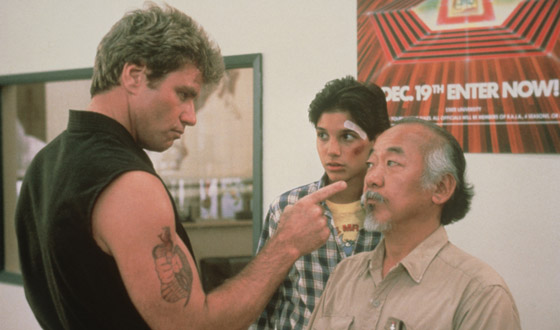
Traditional and competitive martial arts approaches as dramatized in “The Karate Kid” claim positive effects on teen development but Michael E. Trulson was the first to study actual outcomes in relationship to confidence, aggression, and other social behaviors.
“The Karate Kid” was the first movie to focus on a teen martial arts hero in the USA. The movie’s popularity mirrored the new market success of youth martial arts programs in the states and (oddly) represents the potential effects of traditional vs. performance based instruction. It is strange to hold “The Karate Kid” up as a cultural influence and defining piece of martial arts history (in the states) but it and Karate Kid II remain 2 of the highest grossing MA movies, topping the movies of Bruce Lee, Chuck Norris, Steven Segal, and many highly trained actual martial artists. Both movies were also in the top 5 for their release year at the box office so all caveats and embarrassment aside there is evidence that consumer expectations as well as instructor efforts are shaped by good ole’ Daniel-san and Mr Miyagi.
The mid-eighties marked an explosion of youth martial arts programs and the central claim was that martial arts would build positive character traits. Trulson published “Martial Arts; A Novel Cure for Juvenile Delinquency” in 1984, demonstrating that martial arts training that incorporated traditional etiquette, moral codes, moral authority, as well as a focus on self-defense in contrast to competition was an effective method of reducing negative behaviors leading to delinquent behavior. In contrast, “modern” or performance based martial arts programs tended to increase negative behaviors even in contrast to the control group that only participated in mentorship activities. What is unique about this study is that all three groups were under the leadership of the same instructor, focusing specifically on the effects of method and eliminating the effects of personality.
After decades of continued research Trulson’s findings remain supported but studies have shown that there is a limit to the effectiveness of MA as “medicine.” Traditional martial arts generally promote the above mentioned pro-social characteristics but the purpose of punching and kicking is in contrast to those goals. As students advance they build character while also building the capacity to be stronger, tougher, and more lethal. Aikido (a non-destructive MA) has shown up in studies but has not been studied closely enough to determine if positive effects increase when injury is not the method of self-defense. Public Health is becoming more open to ways to improve services and are willing to utilize non-violent martial arts such as Aikido if research demonstrates positive effects. Further posts will look at insights found in the 30 years of research that may improve how programs utilize Aikido as outreach. As a start, there is evidence that Aikido technique alone may not make a significant difference.
